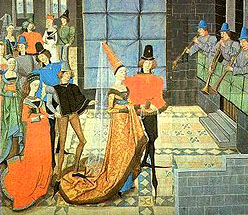
As the arts and sciences flourished in the European Renaissance, dance quickly rose
to preeminence. Dance increased in sophistication and social importance through the 14th century, but
unfortunately no choreographic descriptions survive from this century. It is from preserved music
tabulatures and literature, such as Boccaccio's Decameron, that we know the names of these lost dances,
which include the balli, carola (carole), stampita (estampe, istampita, stantipes), salterello, rotta,
trotto and farandole. Only treatises from later centuries give us any hint as to what these 14th
century dances might have looked like.
The 15th century is the first period in western history to have dances documented well enough for
reconstruction. Several surviving manuscripts describe the dances of the aristocracy, for whom dance
was an important courtly pastime. The dances from the northern courts (primarily Burgundy –
a large area north of the Alps including some of present-day France, Germany and the Netherlands)
tended to be conservative and Gothic. Southern France (Provence) was more innovative, while Italy was
the hotbed of the avant garde.

The primary dance of the Burgundian court was the stately Bassedanse. This was a memorized sequence
of steps performed as a processional, danced to music in "perfect" (i.e. triple) time. One surviving
Burgundian dance source is the beautiful handwritten Brussels manuscript,
penned in gold and silver ink by an anonymous scribe.
The Italian courts also danced the Bassadanza (as they spelled it), although it was lighter in spirit
and somewhat more intricate than the Burgundian Bassedanse. But the epitome of Italian court dance was the Ballo.
The 15th century Balli were beautifully designed choreographies for a set number of dancers that featured
a wide variety of steps, figures and rhythms. Unlike the Bassadanza, the music and dance phrases of the
Balli were inseparable.

Both Bassadanzi and Balli were composed by highly respected dance masters, following specific guidelines
of scientific and artistic movement. The first and most important dance master of the Renaissance was
Domenico da Piacenza (ca. 1395 - ca. 1465). Two of his students represented the next generation of dance
masters: Guglielmo Ebreo (also known as Giovanni Ambrosio) and Antonio Cornazano. Fortunately all three
left detailed manuscripts describing dance theory, deportment, specific choreographies and
corresponding music.
While these surviving 15th century instruction books described the dances from the highest courts, the
dances of the artisans, burghers, lower classes and peasants remained unrecorded until the end of the
16th century.
— Richard Powers